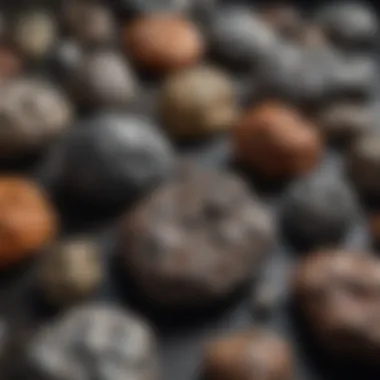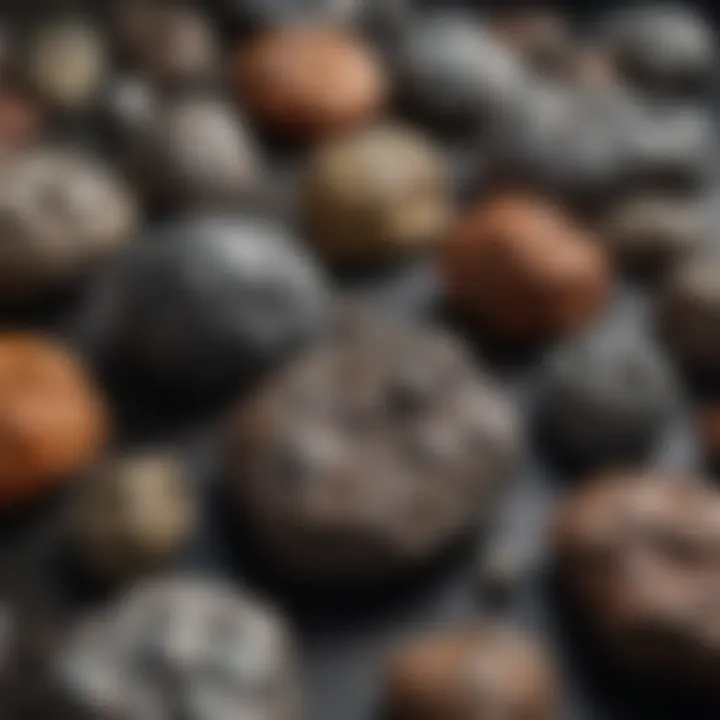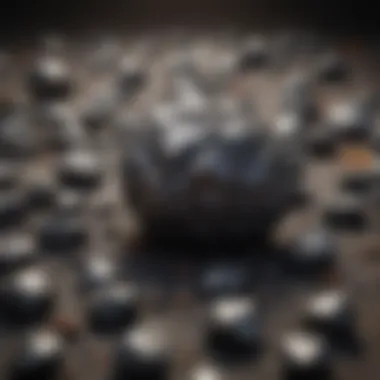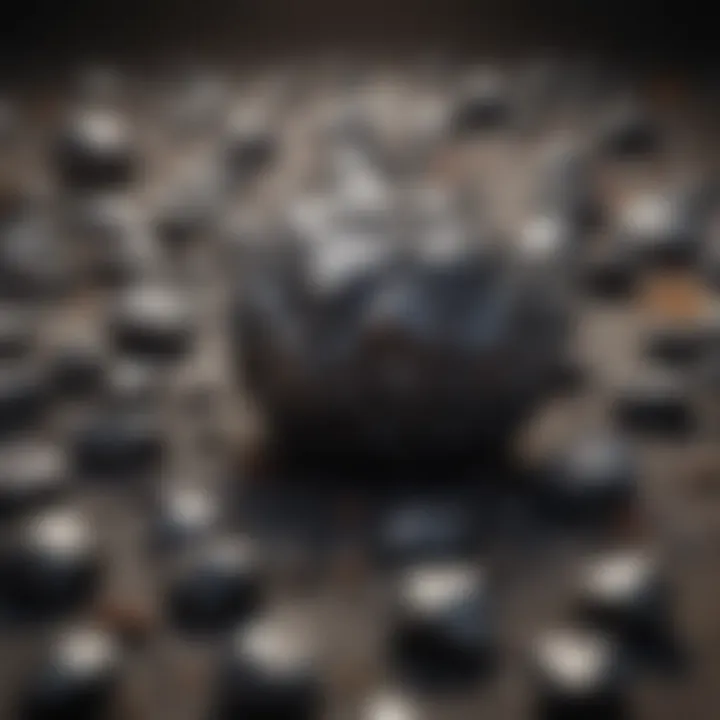Understanding Meteorite Prices: A Collector's Guide


Intro
Meteorites captivate both scientists and collectors alike. Understanding how meteorite prices are established can be complex but rewarding. Each specimen tells a unique story from space, making its value fluctuate based on various factors. In this article, we will navigate through the intricate web of meteorite pricing, focusing on authenticity, classification, and market trends.
Featured Collectible of the Month
Overview
This month, we spotlight the famous Allende meteorite. Fell in 1969 in Mexico, the Allende meteorite is a carbonaceous chondrite. It is known for its scientific importance because it contains organic compounds and presolar grains. Currently, specimens can be valued between $200 and $2,000 per gram, depending on quality and size.
Historical Significance
The Allende meteorite's fall presented opportunities for scientists. It was the largest known fragment found on Earth. The study of its composition has contributed insights into the Solar System's formation. Collectors recognize its importance, making it a desirable item in the meteoritic market.
Identification Techniques
Identifying meteorites is essential for collectors wanting to ensure authenticity.
Visual Characteristics
Meteorites often have unique features:
- Fusion crust, which appears as a dark, glassy surface due to atmospheric entry.
- Often irregular shapes, differing from earthly rocks.
- Metal flakes or chondrules can be visible within the stone.
Familiarizing with these traits aids in distinguishing meteorites from terrestrial rocks.
Resources for Identification
Several resources exist for confirming meteorite authenticity:
- The Meteoritical Society: A valuable resource for research and publications. (https://www.meteoriticalsociety.org)
- Meteorite Market & Collectors Group on Facebook: A platform for discussions and advice directly from experienced collectors. (https://facebook.com)
- Reddit meteoritics community: Engaging forum for questions and shared knowledge. (https://reddit.com)
By understanding the features that distinguish meteorites, collectors can make informed decisions and enhance their collections.
Preamble to Meteorites
Meteorites are more than just remnants of celestial bodies; they hold significance in both scientific and collector communities. Their uniqueness lies in their origin—they are fragments from outer space that have journeyed through the atmosphere and landed on Earth. This introduction serves to highlight the importance of understanding these fascinating objects, especially in the context of their pricing.
Definition and Classification
Meteorites are categorized based on their composition and physical characteristics. The primary classifications are based on mineral content, which is largely divided into three groups: stony meteorites, iron meteorites, and stony-iron meteorites. Each type has distinct features, which influence their desirability among collectors.
Understanding the classification is relevant because it helps buyers recognize the value and rarity of different meteorite types. For instance, stony meteorites are the most common, while iron meteorites tend to command a higher price due to their rarity and historical significance. This knowledge allows collectors to make informed purchasing decisions.
Types of Meteorites
Stony Meteorites
Stony meteorites are predominantly composed of silicate minerals. They make up approximately 94% of all found meteorites. This makes them a common choice for beginning collectors. One key characteristic of stony meteorites is their diverse mineralogy, which can include olivine, pyroxene, and plagioclase.


Stony meteorites offer an entry point for collectors due to their abundance. They often present a range of prices, making them financially accessible. However, the large variety can mean that quality differs widely.
Iron Meteorites
Iron meteorites, composed primarily of iron and nickel, are less common but very prized in collections. They are known for their metallic luster and exhibit uniqueWidmanstätten patterns when cut and polished. This particular feature attracts collectors who appreciate aesthetic qualities.
Their rarity is a significant factor in their pricing. Due to their limited availability and specific appeal, iron meteorites can fetch higher prices compared to stony meteorites. Collectors seeking uniqueness often gravitate toward them because of their striking appearance and the stories they carry.
Stony-Iron Meteorites
Stony-iron meteorites are, as their name implies, a blend of both stony and metallic components. They are rare, forming less than 2% of recognized meteorites. Their dual composition makes them particularly intriguing for scientific study.
The key characteristic of stony-iron meteorites is their ability to showcase both mineral and metallic properties. This unique feature makes them a valuable choice for collectors who desire variety within their collections. However, due to their rarity, they can be more expensive and harder to find on the market.
In summary, the types of meteorites are vital for understanding the market. Each category offers distinct features that appeal to different kinds of collectors, and their rarity directly impacts their pricing. This makes it imperative for potential buyers to familiarize themselves with the types available.
Factors Impacting Meteorite Pricing
Understanding meteorite pricing involves analyzing various factors that contribute to their value in the collectibles market. The complexity of these elements makes it essential for potential buyers to grasp their significance. Meteorite pricing is not solely driven by aesthetic appeal; it embodies a confluence of rarity, authenticity, and market dynamics. Recognizing these factors can significantly enhance the buyer's ability to make informed choices.
Rarity and Demand
Rarity plays a pivotal role in determining the price of a meteorite. The less frequently a type of meteorite is found, the higher its value tends to be. Many collectors seek unique specimens that are not easily available. This high demand for rare meteorites can lead to a steep increase in price, especially when specific characteristics are coveted. Consequently, meteorites that are more common, such as certain stony meteorites, are generally less expensive. Collectors often prioritize rarity because it directly influences the perceived value of their collection.
Conditions and Authenticity
When purchasing meteorites, one of the critical considerations is the condition and authenticity of each piece. Authenticity must be verified to prevent potential fraud, which can significantly impact pricing.
Certification Processes
Certification processes serve as a vital aspect of determining the authenticity of meteorites. Reputable organizations and laboratories, such as the Meteoritical Society, provide certification services to assess the origins and classifications of meteorites. This verification is essential, as it adds credibility and trust to the transaction. Certified meteorites usually sell at a premium due to the assurance they provide collectors. However, obtaining certification can be costly and may take time, which could deter some buyers.
Testing and Analysis
Testing and analysis are fundamental practices for establishing the scientific merit of meteorites. Various methods, including X-ray fluorescence and isotopic analysis, are employed to determine elemental compositions without damaging the specimens. This scientific scrutiny not only confirms authenticity but also highlights the unique characteristics of each meteorite. Understanding these features can vastly improve their marketability, making analysis a worthwhile investment.
Market Trends and Influence
The market for meteorites is influenced by both societal trends and changing interests within the collector community. Observing these trends is crucial for buyers and sellers looking to maximize their investment.
Collector Preferences
Collector preferences are influenced by personal interests and broader cultural shifts. Some years see a surge in popularity for specific types of meteorites, like the Achondrites or the Martian meteorites, often leading to inflated prices. It’s crucial for buyers to stay attuned to these evolving preferences to make informed decisions. Collectors may also prefer meteorites with notable provenance or fall stories, emphasizing their unique backgrounds.
Influence of Media and Popularity
The impact of media cannot be understated when discussing meteorite prices. High-profile auctions, documentaries, or events can cause significant upticks in interest. When meteorites gain coverage, demand often rises appreciably. Such influence can create temporary spikes in value, driven largely by public curiosity and interest. However, this can also lead to price volatility, making it essential for buyers to assess the longer-term value beyond fleeting trends.
What Determines Value?
Understanding what determines the value of meteorites is crucial for both collectors and investors. The price of meteorites is influenced by several elements, including their size and weight, provenance and history, as well as their scientific and educational value. By grasping these aspects, collectors can make informed decisions about potential purchases and enhance their appreciation for these extraordinary celestial objects.


Size and Weight
The size and weight of a meteorite play a significant role in its valuation. Generally, larger meteorites command higher prices. This trend reflects the rarity and desirability of substantial specimens. Additionally, the weight of a meteorite can directly influence shipping costs and handling, which can also affect its total price. Collectors often seek out pieces that not only have impressive measurements but also possess a balanced appearance. In this context, a 200-gram meteorite may be significantly more desirable than a 10-gram piece, even if both originate from the same classification.
Provenance and History
Provenance and history of a meteorite can greatly enhance its value, as collectors often seek items with a compelling background. A meteorite's documented journey from the sky to Earth can include notable fall locations as well as its trajectory through scientific study, which adds to its narrative and significance.
Notable Fall Locations
The geographical origins of a meteorite can greatly influence its perceived desirability. Meteorites that have fallen in well-documented events or notable locations often attract more interest. For instance, the Chelyabinsk meteorite gained global attention due to its spectacular entrance into Earth's atmosphere in 2013.
These notable fall locations add a layer of intrigue and authenticity that collectors appreciate. However, one must take care when purchasing meteorites associated with dubious falls as these stories can sometimes be fabricated. Ensuring the credibility of the provenance is vital for maintaining a meteorite's value.
Historical Significance
The historical significance of a meteorite also contributes to its value in the market. A meteorite that has played a role in a scientific breakthrough or historical event usually bears a higher price tag. Artifacts linked with a significant event in human history, such as the Tunguska event, often garner attention and can enhance their value for collectors.
Understanding the narrative, including when and how a meteorite was discovered or how it has been used in research, is essential. This context not only enriches the collecting experience but also validates the investment in a unique celestial specimen.
Scientific and Educational Value
Scientific and educational value embodies another critical factor in determining meteorite prices. Meteorites can provide essential insights into the formation of our solar system. Those that possess unique features or compositions may be seen as essential samples for research, raising their market value significantly.
For collectors, the educational aspect can be appealing as it allows them to contribute to scientific knowledge while owning a piece of the cosmos. Invested collectors often appreciate specimens that serve as excellent teaching tools, further justifying their higher prices.
Meteorite Auctions and Sales
Meteorite auctions and sales play a crucial role in the collectibles market. They provide a platform for collectors to acquire unique pieces while offering sellers a venue to reach potential buyers. Understanding how these auctions operate can help both new and seasoned collectors make informed decisions regarding purchases and investments. The dynamics of auction environments can significantly affect pricing, driven by competition, rarity, and timely market trends.
Auction Platforms
There are various platforms available for purchasing meteorites through auctions. Some of the most notable ones include:
- eBay: A widely used platform that allows a range of sellers, from individual enthusiasts to established dealers, to list meteorites for auction. The diverse offerings provide opportunities to obtain both common and rare specimens. However, one must tread carefully due to variability in seller credibility.
- Heritage Auctions: This auction house specializes in high-value collectibles, including meteorites. Their more curated approach tends to attract serious collectors, which can elevate bidding activity and, consequently, prices.
- Bonhams: Known for its prestigious auction events, Bonhams often features meteorite collections. Their auctions tend to draw attention due to their reputation and the quality of specimens showcased.
- In-person Auctions: Local mineral and gem shows often have auction events that allow direct bidding on meteorites. These can be beneficial for personal inspection before making a purchase.
Online and in-person auction platforms each have their own advantages. Online platforms offer convenience and a broader reach, while in-person auctions provide the advantage of tactile examination of meteorite authenticity.
Private Sales vs. Auctions
When considering how to acquire meteorites, both private sales and auctions present distinct options, each with its own merits and considerations.
- Private Sales: In private transactions, buyers and sellers negotiate terms directly. This can lead to more flexible pricing and customized arrangements. Knowledge of both parties' authenticity and reputation is crucial in this scenario. Private sales also may not attract the bidding competition typically seen at auctions, which can lead to more stable pricing.
- Auctions: Auctions provide a transparent bidding process which creates a fair market environment. They can lead to higher prices as multiple bidders compete for the same item. Auction platforms usually have established guidelines and standards for valuation, ensuring greater trust in the purchase.
When selecting between these two options, potential buyers should weigh the significance of price, authenticity, and the nature of the specimen they seek. Each route offers different experiences and may affect the overall investment made in meteorite collecting.
Tips for Buying Meteorites
Buying meteorites is an endeavor that requires careful thought and preparation. The excitement of owning a piece of the cosmos can often overshadow the nuances that come with the purchasing process. Understanding the importance of informed choices cannot be understated, especially in a market that combines both passion and investment.


Research and Education
One of the foremost steps in buying meteorites is conducting thorough research. Knowledge is your best ally. Familiarize yourself with different types of meteorites, such as stony meteorites and iron meteorites. Knowing the characteristics that distinguish them helps in evaluating potential purchases. Educational resources are abundant. Websites like Wikipedia and Britannica provide foundational understanding.
Additionally, join online communities such as Reddit or related Facebook groups. Engage with collectors who can share their experiences, insights, and recommendations. Attend meteorite shows or exhibitions to see specimens up close and talk directly to sellers.
This information will empower you to make informed decisions amid the complexities of meteorite pricing.
Identifying Reputable Sellers
Finding reputable sellers is vital to ensure authenticity and fair pricing. First, look for established vendors with a strong online presence. Credentials matter; check for memberships in recognized associations, such as the International Meteorite Collectors Association.
Read reviews and testimonials from previous customers. Platforms like eBay have specific seller ratings that can guide your decision.
It is advisable to avoid new sellers with little or no feedback, especially if significant investments are involved.
Make sure the seller provides adequate documentation, including certificates confirming authenticity. Discuss the source of the meteorites as provenance can significantly influence value. A trustworthy vendor will be transparent about the history of their pieces, which is crucial for your buying confidence.
Understanding Market Value
Grasping the market value of meteorites is essential for making smart purchases. Like any collectible, meteorite prices fluctuate based on various factors including rarity, demand, and scientific interest.
Research recent auction sales and understand current market trends. Using data from auction platforms can provide insight into pricing patterns.
Study specific types of meteorites and their respective price points. For instance, a rare specimen may fetch a higher price, while more common types may be more affordable.
Be cautious of prices that seem too good to be true. Compare these figures against reputable sources. Keeping abreast of trends will help you determine whether a piece is worth its asking price, thus aiding in making informed investments.
Ultimately, knowledge and careful consideration open the door to becoming an informed collector with a strong appreciation for the material culture of our universe.
The Future of Meteorite Collecting
The realm of meteorite collecting is poised for significant evolution. As more individuals become curious about these celestial fragments, the market is likely to experience shifts. Recognizing future trajectories is essential for both new and seasoned collectors. Understanding trends can lead to more informed purchasing decisions. Likewise, it can enhance collectors' appreciation of these alien specimens, connecting them to a broader narrative of our universe.
Emerging Trends
Several trends are changing the landscape of meteorite collecting. Firstly, the increase in accessibility has broadened the collector base. With online auctions and dedicated platforms, a wider array of meteorites is now available. This will likely increase competition and elevate prices. Many people now see meteorites not only as collectibles but also as investments.
Moreover, younger collectors are entering the field, bringing fresh perspectives and interests. This shift includes a focus on unique specimens, like lunar or Martian meteorites, which have captured the imagination of both enthusiasts and scholars. The growing interest in space exploration and science education contributes to this trend.
In addition, public awareness is increasing due to media coverage and educational programs about meteorites. Documentaries and online content highlighting their significance reinforce their allure. This trend could lead to higher demand and affect pricing strategies in the market.
Technological Advances in Authenticity Verification
With the rising interest in meteorites, the authenticity of these specimens has never been more critical. Technology is now playing a vital role in verifying meteorite claims. Advanced techniques like isotopic analysis and mass spectrometry are improving authentication processes. These methods help distinguish real meteorites from imitations which are prevalent in the market.
Certification bodies play a crucial role in the future of meteorite collecting. Their standards ensure that collectors receive genuine items. The process of getting a meteorite certified usually involves rigorous testing, which can include radiometric dating and mineralogical analysis. As technology develops, these processes will likely become more accessible and affordable for collectors.
In summary, the future of meteorite collecting appears promising and dynamic. Emerging trends indicate growing excitement and participation in the field. At the same time, technological advances ensure that authentication remains robust. As awareness and interest continue to expand, collectors can expect a vibrant marketplace where they can connect with history and science through these remarkable celestial stones.
Closure
Summary of Key Points
To recap the important elements discussed throughout this article:
- Rarity and Demand: Limited supply directly influences prices. Unique meteorites can command higher prices due to their rarity.
- Conditions and Authenticity: Provenance significantly affects value. Certified meteorites tend to be more desirable to collectors.
- Market Trends: Fluctuations based on collector interest and media hype can affect pricing.
- Value Determinants: Size, weight, and historical significance play crucial roles in determining worth.
"The value of meteorites lies not merely in their physical attributes but also in their story and uniqueness."
Final Thoughts on Making Informed Investment Choices
Making informed choices when investing in meteorites requires more than superficial knowledge. Collectors must consider various aspects, such as the credibility of the seller and the meteorite's background. Here are some key considerations:
- Conduct Thorough Research: Familiarize yourself with types of meteorites and their distinct characteristics.
- Verify Seller Reputation: Look for reputable dealers or auction platforms that specialize in meteorites.
- Assess Market Value: Stay updated on market trends and understand the factors that influence meteorite pricing.
By doing so, potential buyers can navigate the complexities of the market efficiently. They can enhance both their collection and appreciation for these otherworldly specimens.



